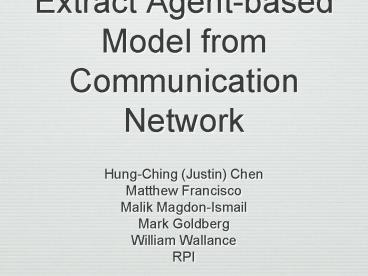Extract Agent-based Model from Communication Network PowerPoint PPT Presentation
Title: Extract Agent-based Model from Communication Network
1
Extract Agent-based Model from Communication
Network
- Hung-Ching (Justin) Chen
- Matthew Francisco
- Malik Magdon-Ismail
- Mark Goldberg
- William Wallance
- RPI
2
Goal
Given a societys communication history, can we
- Deduce something about nature of the society
- e.g., Do actors generally have a propensity to
join small groups or large groups? - Predict the societys future
- e.g., How many social groups are there after 3
months? - e.g., What is the distribution of group size?
3
General Approach
Individual Behavior (Micro-Laws)
Learn
Societys History
Predict (Simulate)
Societys Future
4
General Approach
Individual Behavior (Micro-Laws)
Learn
Predict (Simulate)
Societys Future
5
Social Networks
- Individuals
- (Actors)
- Groups
6
Social Networks
- Individuals
- (Actors)
1
2
- Join
- Leave
- Groups
3
7
Social Networks
- Individuals
- (Actors)
1
- Join
- Leave
- Groups
- Disappear
- Appear
- Re-appear
3
8
Societys History
9
General Approach
Individual Behavior (Micro-Laws)
Learn
Societys History
Predict (Simulate)
Societys Future
10
Modeling of Dynamics
11
Example of Micro-Law
Actor X likes to join groups.
SMALL
LARGE
Parameter
12
ViSAGEVirtual Simulation and Analysis of Group
Evolution
State Properties of Actors and Groups
Decide Actors Action
State
Normative Action
State
State update
Actor Choice
State
Process Actors Action
Feedback to Actors
Real Action
13
General Approach
Individual Behavior (Micro-Laws)
Learn
Societys History
Predict (Simulate)
Societys Future
14
Learning
?
Learn
?
15
Groups Group Evolution
16
Actors Types
- Leader prefer small group size and is most
ambitious - Socialite prefer medium group size and is medium
ambitious - Follower prefer large group size and is least
ambitious
17
Learning Actors Type
- Maximum log-likelihood learning algorithm
- Cluster algorithm
- EM algorithm
18
Testing Simulation Data
19
Testing Real Data
20
General Approach
Individual Behavior (Micro-Laws)
Learn
Societys History
Predict (Simulate)
Societys Future
21
Testing Simulations
22
Prediction
23
Prediction
24
Future Work
- Test Other Predictions
- e.g., membership in a particular group
- Learn from Other Real Data
- e.g., emails and blogs
25
Questions?
PowerShow.com is a leading presentation sharing website. It has millions of presentations already uploaded and available with 1,000s more being uploaded by its users every day. Whatever your area of interest, here you’ll be able to find and view presentations you’ll love and possibly download. And, best of all, it is completely free and easy to use.
You might even have a presentation you’d like to share with others. If so, just upload it to PowerShow.com. We’ll convert it to an HTML5 slideshow that includes all the media types you’ve already added: audio, video, music, pictures, animations and transition effects. Then you can share it with your target audience as well as PowerShow.com’s millions of monthly visitors. And, again, it’s all free.
About the Developers
PowerShow.com is brought to you by CrystalGraphics, the award-winning developer and market-leading publisher of rich-media enhancement products for presentations. Our product offerings include millions of PowerPoint templates, diagrams, animated 3D characters and more.

